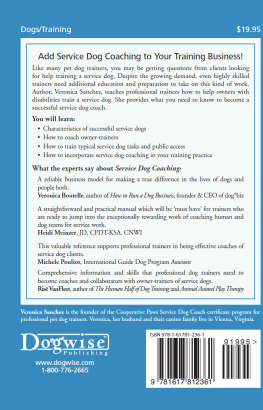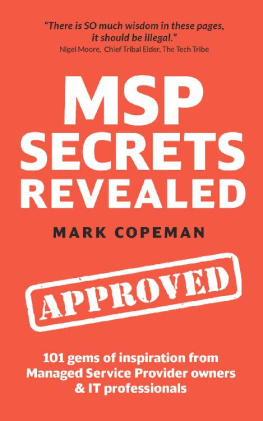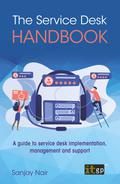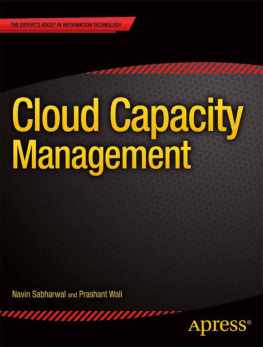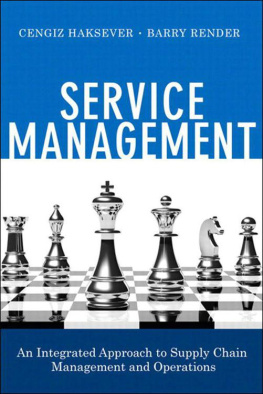Nahari Ami - Secrets of service level management: a process owners guide
Here you can read online Nahari Ami - Secrets of service level management: a process owners guide full text of the book (entire story) in english for free. Download pdf and epub, get meaning, cover and reviews about this ebook. City: London, year: 2013, publisher: The Stationery Office Ltd;Tso, genre: Business. Description of the work, (preface) as well as reviews are available. Best literature library LitArk.com created for fans of good reading and offers a wide selection of genres:
Romance novel
Science fiction
Adventure
Detective
Science
History
Home and family
Prose
Art
Politics
Computer
Non-fiction
Religion
Business
Children
Humor
Choose a favorite category and find really read worthwhile books. Enjoy immersion in the world of imagination, feel the emotions of the characters or learn something new for yourself, make an fascinating discovery.
- Book:Secrets of service level management: a process owners guide
- Author:
- Publisher:The Stationery Office Ltd;Tso
- Genre:
- Year:2013
- City:London
- Rating:3 / 5
- Favourites:Add to favourites
- Your mark:
- 60
- 1
- 2
- 3
- 4
- 5
Secrets of service level management: a process owners guide: summary, description and annotation
We offer to read an annotation, description, summary or preface (depends on what the author of the book "Secrets of service level management: a process owners guide" wrote himself). If you haven't found the necessary information about the book — write in the comments, we will try to find it.
Nahari Ami: author's other books
Who wrote Secrets of service level management: a process owners guide? Find out the surname, the name of the author of the book and a list of all author's works by series.
Secrets of service level management: a process owners guide — read online for free the complete book (whole text) full work
Below is the text of the book, divided by pages. System saving the place of the last page read, allows you to conveniently read the book "Secrets of service level management: a process owners guide" online for free, without having to search again every time where you left off. Put a bookmark, and you can go to the page where you finished reading at any time.
Font size:
Interval:
Bookmark:

Secrets of Service Level Management
A process owners guide
London: TSO

Published by TSO (The Stationery Office) and available from:
Online
www.tsoshop.co.uk
Mail, Telephone, Fax & E-mail
TSO
PO Box 29, Norwich, NR3 1GN
Telephone orders/General enquiries: 0870 600 5522
Fax orders: 0870 600 5533
E-mail:
Textphone: 0870 240 3701
TSO@Blackwell and other Accredited Agents
The Stationery Office 2013
All rights reserved. No part of this publication may be reproduced, stored in a retrieval system, or transmitted in any form or by any means, electronic, mechanical, photocopying, recording or otherwise without the permission of the publisher.
Copyright in the typographical arrangement and design is vested in The Stationery Office Limited.
Applications for reproduction should be made in writing to The Stationery Office Limited, St Crispins, Duke Street, Norwich NR3 1PD.
No liability is accepted for any loss resulting from use of or reliance on this content. While every effort is made to ensure the accuracy and reliability of the information, TSO cannot accept responsibility for errors, omissions or inaccuracies.
Ami Nahari has asserted his moral rights under the Copyright, Designs and Patents Act 1988, to be identified as the author of this work.
The Swirl logo is a trade mark of the Cabinet Office
ITIL is a registered trade mark of the Cabinet Office
The Best Management Practice Official Publisher logo is a trade mark of the Cabinet Office
The Best Management Practice Portfolio Product logo is a trade mark of the Cabinet Office
A CIP catalogue record for this book is available from the British Library
A Library of Congress CIP catalogue record has been applied for
First published 2013
ISBN 9780113313525
Printed in the United Kingdom for The Stationery Office, London
P002468774 c8 03/13
List of figures
List of tables
About the authoring team
THE AUTHOR
Ami Nahari
As an expert in the field of IT service management (ITSM), ITIL and service level management (SLM), Ami Nahari has assessed and implemented SLM processes for Fortune 100 companies. In addition to his 15 years of experience, he brings first-rate project management skills, a creative approach and proven leadership to his role as author.
PMI and ITIL V3 Expert certified, Ami has written articles and spoken extensively about the methodology he developed relating to IT service performance measurements and service level manager responsibilities. He holds a BS (Hons) in Political and Management Science from Bar Ilan University, Ramat Gan, Israel, and shows real commitment and enthusiasm in all his chosen fields.
Ami has lived in Israel, Toronto, Ireland and San Francisco, and he currently resides in New York City.
THE CONTRIBUTORS
Craig J. LaCava
Craig J. LaCava has been an IT management and business consultant for more than 16 years. During his career, Craig has specialized in ITSM, IT strategy and planning, business continuity and IT governance. Craig has consulted with Fortune 100 companies across North America, Europe and Asia.
Craig earned the ITIL IT Service Manager certificate with distinction from the Information Systems Examination Board (ISEB) in 2005 and now holds the ITIL V3 Expert certificate. He specializes in helping IT organizations to achieve more effective and efficient operations and governance through the adaptation of ITIL, ISO 20000 and other best-practice frameworks.
Craig holds a BS (Hons) in Computer Science from the Georgia Institute of Technology and lives in Atlanta, Georgia.
Joe Fennis
Joe Fennis is a highly skilled SLM solutions designer and architect. Joe has worked in the ITSM domain for more than 12 years, specializing in service level agreement (SLA) management, and focusing on metric, key performance indicator (KPI) and SLA calculations. Joe has consulted and implemented several ITSM projects for companies in Australia, Europe and the United States.
Joe holds a Bachelor degree in information technology from Griffith University, Australia, and now lives and works in Belgium.
Acknowledgements
AUTHOR ACKNOWLEDGEMENTS
Special thanks to Tanya Benson and Kim Donica, who spent hours upon hours editing my chapters to ensure that the writing standards were high and that the guidance contained in this publication would be clear to all audiences. Beyond editing capabilities, both Tanya and Kim provided highly skilled ITSM feedback which helped the author immensely.
Other contributors include Khaled Aly, Eli Anhang, Mike Cartoscelli, Mike Efstathiou, Tzachi Golan, Molnar John, Yakov Kogan, Pascal Marat, Larissa Montrose, Kevin Mullen, Eitan Rafael, Eric Reich, Ross Richardson, Loren Shumway, Mark Stadtmueller, Kathy Steinway, Drew Terranova, Lloyd Turner, Mark Walter, Martin Williamson, Scott Wilson, Ivri Yair and David Zemon.
PUBLISHER ACKNOWLEDGEMENTS
The Stationery Office (TSO) would like to thank itSMF for its help in the quality assurance of this publication. Thanks are also due to those people who generously donated their time in reviewing this title, including George Kinnear of The Grey Matters, Paul Wigzel of Paul Wigzel Training and Consultancy, and Dot Tudor of TCC.
Preface
People ask me if I like to travel. Well, I like meeting new people and visiting new cultures, and I like escaping my daily routine and going on vacation, but all of these usually involve going through numerous airport security checks, which I dont like at all.
Recently, I flew from New York to Toronto. My flight was scheduled to depart at 6:30 p.m. and arrive at 8:00 p.m. The chaos in the airport was unbearable: it was difficult to get hold of the desk attendant; flights were being cancelled; and departure gates were being changed by the minute. Our plane finally left the gate at 7:00 p.m., and then taxied for more than an hour and a half until we were airborne at 8:30 p.m., to land in Toronto at 9:30 p.m. Many people missed their connecting flights and were forced to stay the night in the airport. Toronto was my destination but I, too, was delayed a while longer, as local immigration officials decided to take me through some additional inspection. Needless to say, my plans for the evening were ruined.
Examined through service management standards, my flight experience failed every single metric: response time, resolution time, performance, availability and, above all, customer satisfaction. This happened for one simple reason: there was no alternative service.
The objective of service level management (SLM) is to defy precisely that outcome. The process goal is to interface with the customer and ensure their satisfaction. SLM is a core ITIL process because it examines the actual quality of service as the customer perceives it and how happy the customer is with it. Happy is not an IT term and cannot be tracked by a monitoring tool, and that is why SLM is different from other processes.
You can have a service level agreement (SLA) report showing 100% scores for every objective, but if your customer satisfaction is lagging, you must start a new record in your continual service improvement (CSI) register and prioritize this item. Likewise, you may have an SLA report indicating warnings and even breaches in some of your objectives, but if your customers are happy, you must be doing something right.
Next pageFont size:
Interval:
Bookmark:
Similar books «Secrets of service level management: a process owners guide»
Look at similar books to Secrets of service level management: a process owners guide. We have selected literature similar in name and meaning in the hope of providing readers with more options to find new, interesting, not yet read works.
Discussion, reviews of the book Secrets of service level management: a process owners guide and just readers' own opinions. Leave your comments, write what you think about the work, its meaning or the main characters. Specify what exactly you liked and what you didn't like, and why you think so.


